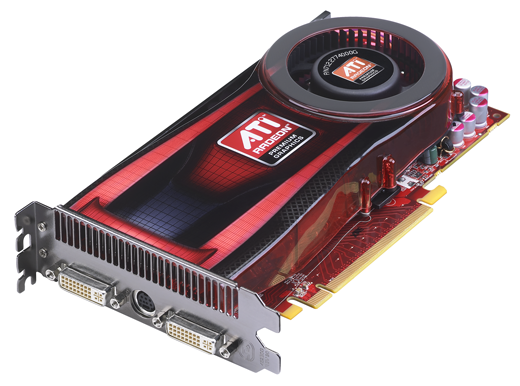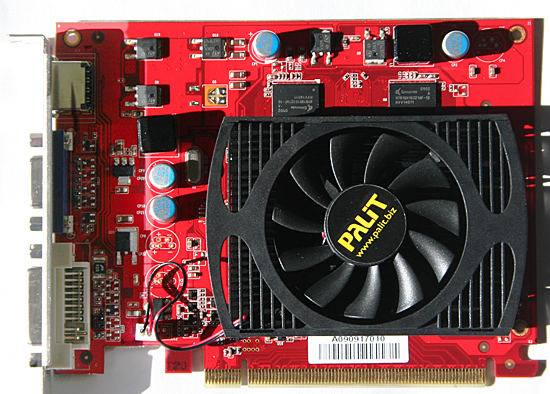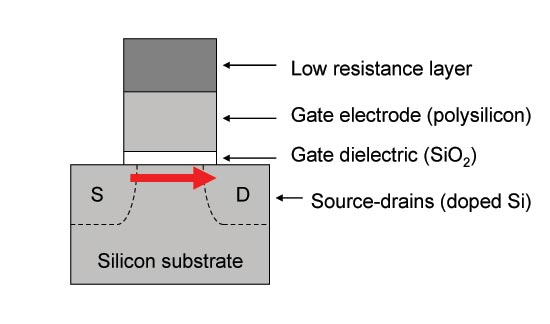The RV870 Story: AMD Showing up to the Fight
by Anand Lal Shimpi on February 14, 2010 12:00 AM EST- Posted in
- GPUs
The Payoff: How RV740 Saved Cypress
For its first 40nm GPU, ATI chose the biggest die that made sense in its roadmap. That was the RV740 (Radeon HD 4770):

The first to 40nm - The ATI Radeon HD 4770, April 2009
NVIDIA however picked a smaller die. While the RV740 was a 137mm2 GPU, NVIDIA’s first 40nm parts were the G210 and GT220 which measured 57mm2 and 100mm2. The G210 and GT220 were OEM-only for the first months of their life, and I’m guessing the G210 made up a good percentage of those orders. Note that it wasn’t until the release of the GeForce GT 240 that NVIDIA made a 40nm die equal in size to the RV740. The GT 240 came out in November 2009, while the Radeon HD 4770 (RV740) debuted in April 2009 - 7 months earlier.

NVIDIA's first 40nm GPUs shipped in July 2009
When it came time for both ATI and NVIDIA to move their high performance GPUs to 40nm, ATI had more experience and exposure to the big die problems with TSMC’s process.
David Wang, ATI’s VP of Graphics Engineering at the time, had concerns about TSMC’s 40nm process that he voiced to Carrell early on in the RV740 design process. David was worried that the metal handling in the fabrication process might lead to via quality issues. Vias are tiny connections between the different metal layers on a chip, and the thinking was that the via failure rate at 40nm was high enough to impact the yield of the process. Even if the vias wouldn’t fail completely, the quality of the via would degrade the signal going through the via.
The second cause for concern with TSMC’s 40nm process was about variation in transistor dimensions. There are thousands of dimensions in semiconductor design that you have to worry about. And as with any sort of manufacturing, there’s variance in many if not all of those dimensions from chip to chip. David was particularly worried about manufacturing variation in transistor channel length. He was worried that the tolerances ATI were given might not be met.

A standard CMOS transistor. Its dimensions are usually known to fairly tight tolerances.
TSMC led ATI to believe that the variation in channel length was going to be relatively small. Carrell and crew were nervous, but there’s nothing that could be done.
The problem with vias was easy (but costly) to get around. David Wang decided to double up on vias with the RV740. At any point in the design where there was a via that connected two metal layers, the RV740 called for two. It made the chip bigger, but it’s better than having chips that wouldn’t work. The issue of channel length variation however, had no immediate solution - it was a worry of theirs, but perhaps an irrational fear.
TSMC went off to fab the initial RV740s. When the chips came back, they were running hotter than ATI expected them to run. They were also leaking more current than ATI expected.
Engineering went to work, tearing the chips apart, looking at them one by one. It didn’t take long to figure out that transistor channel length varied much more than the initial tolerance specs. If you get a certain degree of channel length variance some parts will run slower than expected, while others would leak tons of current.
Engineering eventually figured a way to fix most of the leakage problem through some changes to the RV740 design. The performance was still a problem and the RV740 was mostly lost as a product because of the length of time it took to fix all of this stuff. But it served a much larger role within ATI. It was the pipe cleaner product that paved the way for Cypress and the rest of the Evergreen line.
As for how all of this applies to NVIDIA, it’s impossible to say for sure. But the rumors all seem to support that NVIDIA simply didn’t have the 40nm experience that ATI did. Last December NVIDIA spoke out against TSMC and called for nearly zero via defects.
The rumors surrounding Fermi also point at the same problems ATI encountered with the RV740. Low yields, the chips run hotter than expected, and the clock speeds are lower than their original targets. Granted we haven’t seen any GF100s ship yet, so we don’t know any of it for sure.
When I asked why it was so late with Fermi/GF100, NVIDIA pointed to parts of the architecture - not manufacturing. Of course, I was talking to an architect at the time. If Fermi/GF100 was indeed NVIDIA’s learning experience for TSMC’s 40nm I’d expect that its successor would go much smoother.
It’s not that TSMC doesn’t know how to run a foundry, but perhaps the company made a bigger jump than it should have with the move to 40nm:
| Process | 150nm | 130nm | 110nm | 90nm | 80nm | 65nm | 55nm | 40nm |
| Linear Scaling | - | 0.866 | 0.846 | 0.818 | 0.888 | 0.812 | 0.846 | 0.727 |
You’ll remember that during the Cypress discussion, Carrell was convinced that TSMC’s 40nm process wouldn’t be as cheap as it was being positioned as. Yet very few others, whether at ATI or NVIDIA, seemed to believe the same. I asked Carrell why that was, why he was able to know what many others didn’t.
Carrell chalked it up to experience and recounted a bunch of stuff that I can’t publish here. Needless to say, he was more skeptical of TSMC’s ability to deliver what it was promising at 40nm. And it never hurts to have a pragmatic skeptic on board.










132 Comments
View All Comments
wlee15 - Sunday, February 14, 2010 - link
The USS Hornet is a carrier not a battleship.For shame Anand For Shame!
Anand Lal Shimpi - Monday, February 15, 2010 - link
wow - you're totally right, I can't believe I made that mistake. Looks like Ryan or Jarred caught it shortly after it went live though, whew :)And yes, for the record, I know the difference between an aircraft carrier and a battleship :)
Take care,
Anand
just4U - Tuesday, February 16, 2010 - link
LIES!!!!(hah)
Sahrin - Sunday, February 14, 2010 - link
Thank you - I was worried I'd be the only one to point this one out.Thank you Anand! This stuff is incredible. Just a few weeks ago I was looking back on the RV770 article and wishing it could be done again.
Kudos as well are due to AMD's PR guys - for having the courage to let the engineers sit down with the press, instead of needing to be there as minders. I guarantee you that every single time, the same story told by a marketer of a product and by the guy whose passion created the product will be a thousand times more effectively conveyed by the engineer. Marketers have value - I'm not trying to write them off.
I don't know what I can do for AT and AMD to thank them for making articles like this happen. Aside from buying Cypress and being a reader - but if there is anything we can do to ensure these articles keep coming (bombard Meyer with Faxes?) let me be the first to sign up. (And maybe if we could get access to AMD's CPU guys as well, to provide a balance to the excellent information we get from Intel).
Dianoda - Sunday, February 14, 2010 - link
This article was a real treat, keep 'em coming...dzx - Monday, February 22, 2010 - link
I created an account just to give thanks for such a well written, informative article. I can sense you have just as much passion for the technology as the engineers and architects who create it. Simply a pleasure to read.gralex - Friday, February 26, 2010 - link
Thanx. I have nothing more to add that hasn't been said already in the above comments, just thanks.As for ATI vs. NVIDIA, maybe i'm believing the hype but AMD seems awfully conservative at the moment. It's totally working for them, of course, but I'm liking the whole CUDA, Tegra2, Ion, Optimus momentum Nvidia might finally be gaining right now. Obviously they messed it up with a ton of rebranding making a 5xxx purchase a no-brainer right now... I just LOVE the way Nvidia was looking cornered and thought up a number of ways to get out. I hope these two keep up the healthy rivalry for many years to come, for ALL of us:-)
phaxmohdem - Sunday, February 14, 2010 - link
Wow. This was perhaps the first article I've read in a long time I read cover-to-cover, and couldn't put down. AT is my favorite tech review site, but I find myself reading the first two pages or so, skipping around to various benchmark pages, then reading the summary. This piece was remarkably intriguing and thought provoking. I look forward to the RV970 story, or perhaps better yet, the GF100 story.Keep em coming!
gimmeausername - Sunday, February 14, 2010 - link
Did you just say RV970?I think you've just made some folks at AMD flip out by using that code name. :D
coolhardware - Sunday, February 14, 2010 - link
As others have mentioned, articles like this one really put Anandtech head and shoulders above the competition. It is so very interesting to find out the real world story behind the video cards. What a wonderful Valentine's Day treat :-).Thanks for all your hard work Anand, I really appreciate it!